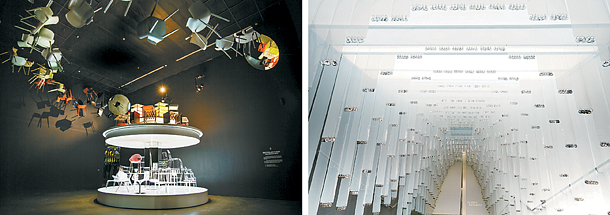One hundred fantastic years of plastic design

“Plastic Fantastic,” being held at the D Museum in central Seoul, looks at the versatility of plastic as a material that is not only practical but also carries potential as a subject of art. Left, invisible chairs designed by Philippe Starcke. Right, a display at the entrance of the museum made by Korean design collective Showmakers. [D MUSEUM]
Featuring over 2,700 pieces by some 40 creators, the exhibition explores diverse perspectives on the use and design of the artificial material. From furniture, commercial products and graphics to photographs and lights, the vast range of works celebrates the flexibility of plastic as not only a raw material for practical uses, but also its versatility in art. Over 70 percent of the works on display are products manufactured by Italian design company Kartell, which is a sponsor of the exhibition.
“Plastic first came to be used in Korea in the late 50s and 60s, and it was mostly used as a tool for industrial growth at the time,” said Kim Ji-hyun, the curator of Plastic Fantastic. “This exhibition seeks to tell the stories of plastic after it came into our ordinary lives, in the form of furniture and other things we use everyday.”
Entering the museum, visitors walk down a set of stairs with layers of thin plastic strips hanging down from the ceiling that make tingling sounds as the visitors make their way towards the beginning of the exhibition. What may seem like just a pretty decoration is a work by a Korean art collective called Showmakers. The work poses the question of why plastic is considered only a pleasure to the eye, and not the ears.
The first half of the exhibit, on the first floor of the museum, consists mainly of actual furniture, mostly chairs and sofas, which were made during the last century. Each piece visually represents the development of plastic as a material. Starting from simple and small cups to bigger and more complicated designs, each piece symbolizes a new step taken in the development of the material - withstanding higher temperatures, having smoother textures, more complicated designs and better durability. While the first generation of furniture on display shows signs of wear and tear, those made later in the century still hold their original, vivid colors.
The second floor contains works by master designers such as Gino Colombini, Joe Colombo and Philippe Starcke, who gave deeper meaning to the realm of furniture.
Starcke, for example, designed curvy and transparent plastic chairs that could “go anywhere and be anywhere,” since the transparency of the furniture allows for it to fit into any environment and culture. “Plastic is something we made, and it has become an inseparable part to our lives. But it’s also such a creative material, and we can turn our ordinary perceptions with our own creativity to go beyond the common lifestyle,” said curator Kim.
BY YOON SO-YEON [yoon.soyeon@joongang.co.kr]
D Museum is a 15-minute walk from Hangangjin Station, line No. 6, exit 3. Admission is 8,000 won ($7.09) for adults, 5,000 won for students and 3,000 won for children. The museum is closed on Mondays and national holidays, including the upcoming Chuseok holiday. For more information, visit www.daelimmuseum.org/dmseum.










with the Korea JoongAng Daily
To write comments, please log in to one of the accounts.
Standards Board Policy (0/250자)